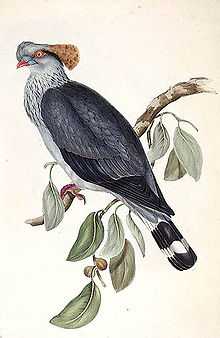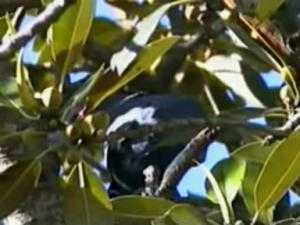Topknot pigeon
| Topknot pigeon | |
|---|---|
 | |
| Hand-coloured lithograph of Lopholaimus antarcticus by Elizabeth Gould (1804–1841) | |
| Conservation status | |
| Scientific classification | |
| Kingdom: | Animalia |
| Phylum: | Chordata |
| Class: | Aves |
| Order: | Columbiformes |
| Family: | Columbidae |
| Genus: | Lopholaimus Gould, 1841 |
| Species: | L. antarcticus |
| Binomial name | |
| Lopholaimus antarcticus (Shaw, 1794) | |
The topknot pigeon (Lopholaimus antarcticus) is a pigeon native to Australia. It is also known by the name of flock pigeon.
Description
The birds are big, with length varying from 40 to 46 centimetres (16 to 18.4 inches). It has a pale grey breast, dark grey wings and a slaty-black tail with one light grey band. The beak is red-brown. The pigeon also has a flattened, wide and sweptback crest of feathers that commences at the beak to the nape of the neck. The crest consists of grey feathers at the front and brown-red feathers at the back. The juveniles are plainer in appearance with a brown bill. The tail band is less defined in the immature.
Habitat
The topknot pigeon generally occurs in groups that may number hundreds. They are strong fliers often seen over rainforests and valleys, but also around palm trees, figs, eucalyptus forests and other woodlands. They are highly arboreal; not only do they feed largely on fruits in the forest canopy, and often roost on trees that stand proud of the canopy, but they also generally rely on rainwater from raindrops in trees. However, in times of shortage, they occasionally forage over open country. Depending on food availability, the species ranges from Cape York in Queensland to near the South Coast of New South Wales, but they have not been reported as far south as Tasmania or the Gippsland Lakes in Victoria.
The species used to occur in enormous numbers in Australian rainforest, but the population declined because of forest clearance and shooting. Because of concern over the steep decline in their population, topknot pigeons now are a protected species in Australia. However the increasing prevalence of a new food source in the fruit of the 'weed' camphor laurel trees has seen a recent resurgence in their number. The birds generally are silent, but sometimes make soft, grumbling, grunting sounds. However, they do commonly squabble with each other and at such times they make short screeching noises rather like the squeals of pigs.
Breeding
Breeding occurs from July to January, when nests are usually built in rainforest trees high above the ground. The nests consist of long and loose twigs. One egg is laid that is large and slightly glossy.

References
- ↑ BirdLife International (2012). "Lopholaimus antarcticus". IUCN Red List of Threatened Species. Version 2013.2. International Union for Conservation of Nature. Retrieved 26 November 2013.
- Pizzey and Knight, "Field Guide to the Birds of Australia", Angus & Robertson, ISBN 0-207-19691-5
- Trounsen and Trounsen, "Australian Birds: A Concise Photographic Field Guide, Cameron House. ISBN 1-875999-47-7.
External links
| Wikimedia Commons has media related to Lopholaimus antarcticus. |
| Wikispecies has information related to: Lopholaimus antarcticus |
